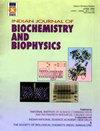褪黑素刺激间充质干细胞衍生外泌体在转移性三阴性乳腺癌中的抗肿瘤活性
IF 1.5
4区 生物学
Q4 BIOCHEMISTRY & MOLECULAR BIOLOGY
引用次数: 0
摘要
本研究的目的是通过将褪黑素加载到外泌体中来提高褪黑素对三阴性乳腺癌(TNBC)细胞的生物利用度,并比较褪黑素和人类脂肪组织源性间充质干细胞释放的外泌体的治疗潜力。TNBC是一种具有高度侵袭性和转移性的恶性肿瘤。其特点是缺乏雌激素受体、孕激素受体和人表皮生长因子受体2。TNBC患者不能从针对这些受体的激素或基于曲妥珠单抗的治疗中获益。外泌体被定义为自然发生的细胞外囊泡。通过使分子转移,外泌体在癌症治疗和肿瘤细胞与相邻间质室之间的动态细胞间通讯中发挥作用。褪黑素与外泌体、at -Exo和Mel共给药组48 h的半最大抑制浓度IC50值分别为30.38µg/mL、40.49µg/mL和1.5 mM。褪黑素与外泌体(2.5 mM +100µg/mL Mel/Exo)共给药组24 h、48 h、72 h的TNBC晚期凋亡诱导率分别为6.3%、4.1%和4.6%。总之,外泌体和褪黑激素的共存代表了一种很有前途的治疗工具,可以干扰TNBC中关键的分子过程,如细胞毒性和凋亡级联。本文章由计算机程序翻译,如有差异,请以英文原文为准。
The Improving anti-tumour activity with melatonin-stimulated mesenchymal stem cell-derived exosomes in metastatic triple-negative breast cancer
The aim of this study is to increase the bioavailability of melatonin on triple-negative breast cancer (TNBC) cells by loading it into exosomes as well as comparing the therapeutic potentials of melatonin and exosome released from human adipose tissue-derived mesenchymal stem cells. TNBC is one of the most malignant tumours with highly invasive and metastatic features. It is characterized by the absence of estrogen receptor, progesterone receptor and human epidermal growth factor receptor 2. TNBC patients can’t benefit from hormonal or trastuzumab-based therapies targeting these receptors. Exosomes are defined as naturally occurring extracellular vesicles. By enabling the transfer of molecules, exosomes play a role in cancer treatment and dynamic intercellular communication between tumour cells and adjacent stromal compartments. The half-maximum inhibitory concentration IC50 values were 30.38 µg/mL, 40.49 µg/mL and 1.5 mM at the co-administered melatonin and exosome, AT-Exo and Mel groups, respectively, for 48 h. The percentage of late-stage apoptotic induction was found to be 6.3%, 4.1% and 4.6% for TNBC exposed to co-administered melatonin and exosome (2.5 mM +100 µg/mL Mel/Exo) for 24 h, 48 h, 72 h, respectively. In conclusion, the coexistence of exosomes and melatonin represents a promising therapeutic tool that can interfere with key molecular processes such as cytotoxicity and apoptosis cascade in TNBC.
求助全文
通过发布文献求助,成功后即可免费获取论文全文。
去求助
来源期刊

Indian journal of biochemistry & biophysics
生物-生化与分子生物学
CiteScore
2.90
自引率
50.00%
发文量
88
审稿时长
3 months
期刊介绍:
Started in 1964, this journal publishes original research articles in the following areas: structure-function relationships of biomolecules; biomolecular recognition, protein-protein and protein-DNA interactions; gene-cloning, genetic engineering, genome analysis, gene targeting, gene expression, vectors, gene therapy; drug targeting, drug design; molecular basis of genetic diseases; conformational studies, computer simulation, novel DNA structures and their biological implications, protein folding; enzymes structure, catalytic mechanisms, regulation; membrane biochemistry, transport, ion channels, signal transduction, cell-cell communication, glycobiology; receptors, antigen-antibody binding, neurochemistry, ageing, apoptosis, cell cycle control; hormones, growth factors; oncogenes, host-virus interactions, viral assembly and structure; intermediary metabolism, molecular basis of disease processes, vitamins, coenzymes, carrier proteins, toxicology; plant and microbial biochemistry; surface forces, micelles and microemulsions, colloids, electrical phenomena, etc. in biological systems. Solicited peer reviewed articles on contemporary Themes and Methods in Biochemistry and Biophysics form an important feature of IJBB.
Review articles on a current topic in the above fields are also considered. They must dwell more on research work done during the last couple of years in the field and authors should integrate their own work with that of others with acumen and authenticity, mere compilation of references by a third party is discouraged. While IJBB strongly promotes innovative novel research works for publication as full length papers, it also considers research data emanating from limited objectives, and extension of ongoing experimental works as ‘Notes’. IJBB follows “Double Blind Review process” where author names, affiliations and other correspondence details are removed to ensure fare evaluation. At the same time, reviewer names are not disclosed to authors.
 求助内容:
求助内容: 应助结果提醒方式:
应助结果提醒方式:


